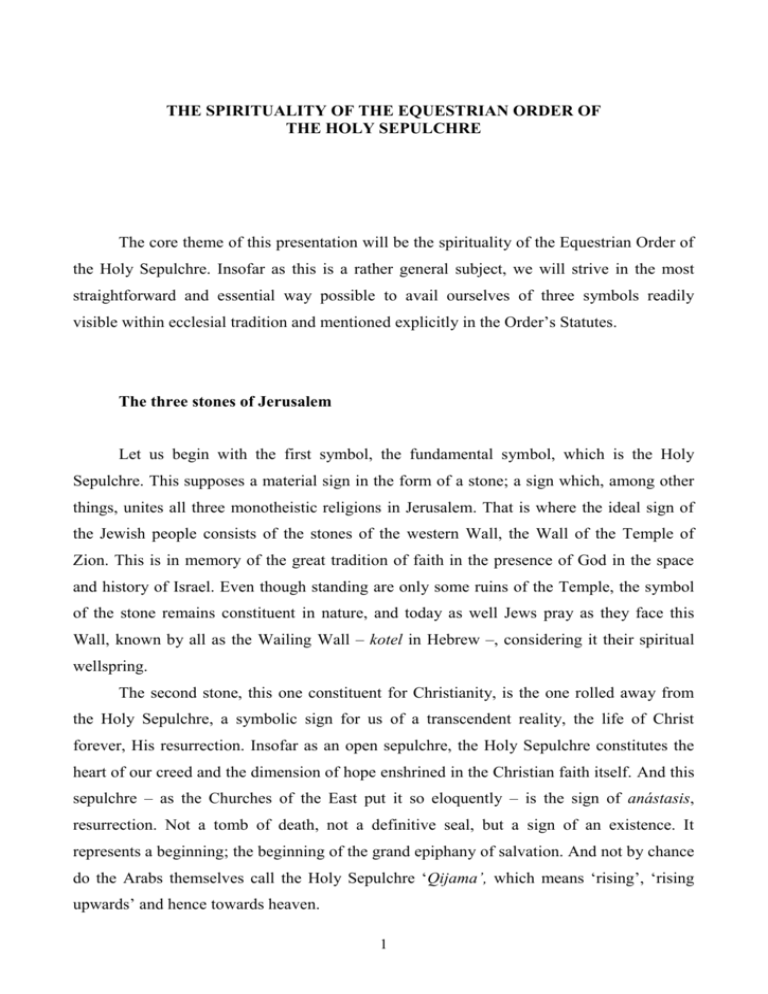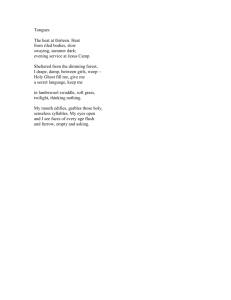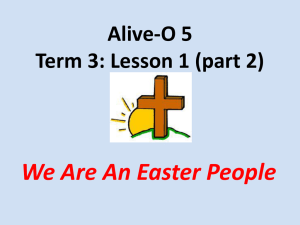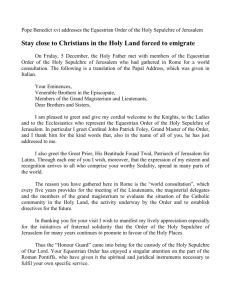la spiritualità dell'ordine equestre del santo sepolcro
advertisement

THE SPIRITUALITY OF THE EQUESTRIAN ORDER OF THE HOLY SEPULCHRE The core theme of this presentation will be the spirituality of the Equestrian Order of the Holy Sepulchre. Insofar as this is a rather general subject, we will strive in the most straightforward and essential way possible to avail ourselves of three symbols readily visible within ecclesial tradition and mentioned explicitly in the Order’s Statutes. The three stones of Jerusalem Let us begin with the first symbol, the fundamental symbol, which is the Holy Sepulchre. This supposes a material sign in the form of a stone; a sign which, among other things, unites all three monotheistic religions in Jerusalem. That is where the ideal sign of the Jewish people consists of the stones of the western Wall, the Wall of the Temple of Zion. This is in memory of the great tradition of faith in the presence of God in the space and history of Israel. Even though standing are only some ruins of the Temple, the symbol of the stone remains constituent in nature, and today as well Jews pray as they face this Wall, known by all as the Wailing Wall – kotel in Hebrew –, considering it their spiritual wellspring. The second stone, this one constituent for Christianity, is the one rolled away from the Holy Sepulchre, a symbolic sign for us of a transcendent reality, the life of Christ forever, His resurrection. Insofar as an open sepulchre, the Holy Sepulchre constitutes the heart of our creed and the dimension of hope enshrined in the Christian faith itself. And this sepulchre – as the Churches of the East put it so eloquently – is the sign of anástasis, resurrection. Not a tomb of death, not a definitive seal, but a sign of an existence. It represents a beginning; the beginning of the grand epiphany of salvation. And not by chance do the Arabs themselves call the Holy Sepulchre ‘Qijama’, which means ‘rising’, ‘rising upwards’ and hence towards heaven. 1 As all pilgrims know so well, the third stone is connected with the “Dome of the Rock”, Qubbet as-Sakhra in Arabic. Even if the definition is erroneous, this is the so-called Mosque of Omar, which, under the splendor of its architecture, has on one side of its center the rock of Abraham’s ideal sacrifice (Mount Moriah), and on the other side the rock of the ascension into heaven of the prophet Mohammed. Hence, it too constitutes a sign of hope for Islam. In Jerusalem, therefore, we have three stones that represent a symbolic foundation of the three monotheistic religions, which can elect this city as their ideal place of encounter. Unfortunately, as we see all too often even nowadays, down through history the holy city has become a place of conflict, a milieu rampant with opposition, while by virtue of its nature it should be the place where the three religions never cease to discover anew their roots and their substance. In this regard – precisely in order to sustain the commitment fielded by the Order of the Holy Sepulchre to protect these stones and safeguard these holy places – I would like to recall two excerpts from the Bible, which in ideal terms could serve as both epigraph and motto also for the intensive activities undertaken by confreres in the painstaking care and attention reserved to monuments and memorials in the Holy Land, and especially Christian ones. The first of these excerpts is to be found in Psalm 102, verse 15, where the psalmist proclaims, “your servants prize the stones of Zion”. The verb used in Hebrew is ratsû, which means ‘to experience pleasure, love’. When one person loves another person that love is not just spiritual in nature, but visceral, or what I would call ‘material’. This dimension of eros, of authentic love, is a deeply interwoven component that is sanctified and blessed. By way of example let’s take the Canticle of Canticles, where eros and love come together and merge with one another in such a perfectly harmonious way. Basically speaking, the psalmist is saying this: for these stones – the stones of Zion evoking our history – we Jews have close to a nuptial love, a complete and full love, not just metaphoric love. This can and must be shared also by Christians. At this juncture I would also like to recall words of Jesus which may well not be cited that often. In the narration of Christ’s entrance into Jerusalem in chapter 19 of the Gospel according to Luke, verses 38-40 recall how all Christ’s disciples cried out: “Peace in heaven and glory in the highest heavens”. The Scribes and Pharisees present, however, told Jesus to have his disciples stop making all that boisterous and disturbing noise. What the 2 disciples were singing, in fact, was a messianic exaltation of Christ that those Scribes and Pharisees were not able to grasp. And Jesus said to them: “I tell you, if these keep silence the stones will cry out”. We who love the Holy Land and have visited it an infinite number of times are able to understand the full sense of the words, “the stones cry out”, the stones speak! Therefore, the pilgrim who goes to visit the Holy Sepulchre or one of the many sites that conserve biblical or Christian memories finds a message “carved”: the message of those living stones that evoke a human and salvific memory, and are not just lifeless archeological finds destined to represent an inanimate and remote past. Therefore, one first important commitment: see to it that through the efforts deployed by the Order, and by way of the voices of the Franciscans, the voices of all the guides, all the visitors and pilgrims, these stones may continue to cry out, speak up, vouch for and narrate our history of faith, our profound hope linked to a religion that is historical and incarnate. Christianity, in fact, is not a religion that propels people to abandon reality in order to fly aloft in the direction of mythical and mystical heavens, but is a religion down to earth – I’d venture to call it a religion with its feet on the ground – a religion of the flesh, of history. Sign and eloquent symbol of it in the strict sense are the stones. The sign of the pilgrimage The second image I would like to bring to your attention is taken from the Order’s Statutes and is the pilgrimage, a theme to be proposed anew from a material point of view, and especially from the spiritual point of view. There is a beautiful Arab aphorism that distinguishes three types of travelers. First there are those who travel with their feet, and these are traders or merchants interested only in a concrete place, no matter where it may actually be, and not its history. If they go to Paris, for example, they don’t go to the Louvre, but are only interested in making good deals. Merchants travel only in a material sense, that is to say with their feet. This proverb continues with the example of those who travel with their eyes: these are the scholars who love cultural journeys and hence could be likened to upper crust tourists and not the masses. In their travels they strive to discover the beauty of other countries, other cultures, and other places yet unknown to them. 3 This Arab proverb then recalls those who travel with their heart, and these are pilgrims. Certainly, pilgrims do use their feet as they travel, do need assistance, must have eyes in order to look upon and know history, but above all they travel in a holy place with their heart and for the conversion of their heart. This is the fundamental difference distinguishing them from all other travelers in the world. Hence the importance of the pilgrimage, but not necessarily in terms of a given geographical space since it is also possible to go on an interior pilgrimage. If we take a close look at the Bible we realize that the Word of God as a whole is constantly marked by a journey, a pilgrimage. Suffice it to consider Abraham, who, without knowing the goal, embarked towards the unknown with the sole assurance of the Word of God, that God who had called him. Everything begins with that call: “Abraham, leave your country” (Gn 12:1). And Abraham leaves, with nary an objection, thereby leading some scholars to assert that Abraham’s vocation is based on a military model: an order is given and promptly carried out. Abraham, however, is aware that God’s grace will guide him. There is no ‘unknown’, no risk wherever God is present. Let us also consider another great pilgrimage in the Bible, the Exodus of the people of Israel. Grandiose indeed was the itinerary traveled by an entire nation across the striking yet mysterious reaches of desert lands in an atmosphere of silence and solitude. During days spent in the deeps of the desert it becomes possible to grasp the richness of this place, this territory so arid, so empty and always the same in the eyes of a superficial observer. The reality of the desert, however, is quite different for someone who sees things with a more attentive eye. For example, the voice of the desert wind is already something different compared with the wind we experience in the cities where we live. Truly discovered in the desert – and this is what Israel was to experience – is the true meaning of what is essential in life in the face of the countless, often useless and harmful superstructures of our sedentary societies, our huge cities and consumerism in general. A person in the desert thinks only about indispensable things like water and food. All the rest is secondary. Hence, Israel is tempted in the desert; the forces of evil cause it to feel discouraged and throw it into a state of despair. Also to be found in the desert, however, is mystical intimacy. It is in the Sinai that the Word of God descends from the mountain top. The prophet Hosea, yearning to establish anew the bond of love with his wife who had left him, wishes to repeat the betrothal and 4 honeymoon right in the desert: “There will I speak to her heart”, we read in the Hebrew text.; in other words tenderly embracing one another in solitude and silence. The desert as such therefore becomes a parable reminding us of the need for a pause in the oasis, in silence. Paschal once said that the majority of the serious mishaps of his time (and all the more so of our time) were due to the fact that people were not able to spend an hour in the silence of their own room. Just five minutes of silence and reflection would suffice today. In this do we realize the value and eloquence of the desert for our time. We should also recall another pilgrimage presented in the Bible, and that is the strictly spiritual pilgrimage to Zion. As we know, present in the Book of Psalms are the fifteen psalms of the “songs of ascents” (Psalms 120-134). This is the handbook of the ideal pilgrim going up to the Temple and thereby ascending, because Jerusalem stands at 800 meters above sea level. However, it is not just a material or physical ascent, but rather a spiritual one. In fact, arrival at the Temple means entering into communion with God. This is why the Jews call the temple ’ohel mo‘ed, which in Hebrew means “tent of the encounter”, “tent of the gathering”, because the Jews meet with one another in the Temple of Zion, but they also encounter their Lord, who says “My name is there”. Now, in the biblical world the “name” is the person himself. God, eternal and infinite, compresses Himself, and even shortens and imprisons Himself within our reality, which is limited space. There, however, is where He encounters His faithful. Important, therefore, is the moment of communion, the moment of the mysticism of the temple. In moments of liturgy, and especially when underway is the pilgrimage to Zion, Israel feels the fullness of its intimacy with the Lord and projects that experience with images as primordial and radical as thirst: “My soul thirsts for God, the God of life; when shall I go to see the face of God” (Ps 42:3). It is likewise interesting to note that the Hebrew word nefesh means both “throat” and “soul”. Hence, it is a matter of a physical thirst that becomes the symbol of interior thirsting in a complete oneness of body and spirit: my throat thirsts for you, oh God, and it is my soul, my entire being, also my body, that needs You. Then appearing, as in psalm 84, is the wistfulness of the pilgrim, who has to return home after having been in Zion. In such a person’s eyes, says the psalmist, more fortunate are the swallows whose nests are just under the temple’s eaves and hence can always be with the Lord. This, therefore, is intimacy in the truest sense of the word. The aim or objective of the pilgrimage to Zion is profound, complete, loving and joyful communion 5 with our God. Then again, the terminal point of the entire Bible is the heavenly Jerusalem located beyond both time and space. Our pilgrimage, the pilgrimage of life itself, therefore has a transcendent goal, and our hope is the dawn of Easter, the glory of communion with God beyond the frontier of death. The great poet Rylke said that death is the face of life other than the one facing us. With death we see that on the other side there is another life with a profile and a countenance we cannot see here and now, but which will be shown to us at the end of our pilgrimage. It would meaningful to recall words taken from a book with which many of you are familiar, the work of an anonymous Russian pilgrim narrating Christian life on the basis of a pilgrimage. The book begins with words that could somehow offer us the portrait of a Knight of the Order of the Holy Sepulchre: “By the grace of God I am a man and a Christian; through my own deeds I am a great sinner; my condition is that of a homeless pilgrim of humble species, who wanders about walking from place to place with nothing but a piece of bread and with the Bible under his cloak”. Therefore, a Christian with grace, but also with his sinfulness; he is above all journeying towards the ultimate eschatological goal. We and people in general travel quite frequently nowadays, and yet, rather paradoxically, we often feel as if we were at a standstill, all on our own, static, tired and dissatisfied, as if nothing at all had been visited, seen and known. The reason for this can be seen in the fact that people today are no longer on a pilgrimage in the quest for noble and eternal goals. Famous are the words Plato placed on the lips of Socrates: “A life without searching doesn’t deserve to be lived”. The Cross of Christ, the supreme symbol Let us conclude with a final image, which is the supreme sign of the spirituality of the Order of the Holy Sepulchre: the symbol of the cross, the center of the Christian faith, and, as we are reminded by John the evangelist, the throne of Christ’s glory. Two are the elements brought to our attention through the cross. First of all, the cross was planted in the Holy Land, and in the Holy Land is in the safekeeping of the Franciscans, of all the Christians living there and who, unfortunately, are fast becoming an increasingly smaller group. I went to the Holy Land for the first time in 1965, more than forty years ago, and have returned quite often. Down through these four decades or so I have witnessed the 6 relentless reduction in the size of the Christian community. Yes, the Christian ‘signs’ are still there, but they seem not really extraneous, but, due to urban development, new cities and a new way of life, somewhat deprived of the force and impact that distinguished them in the past. The Order’s Statutes set forth the need to assist the works and the cultural, charitable and social institutions of the Catholic Church in the Holy Land. This is a way to make sure the cross of Christ continues to shine, that the cross of our brothers and sisters living there amidst difficulties and sufferings may continue to be the cross of life in the Holy Land and not just the cross of monuments, churches, liturgical celebrations and Christian culture. As they have done in the past and are now doing again, complicated and well known political and social problems are staining those beloved stones of the Holy Land with more and more blood. The second and final element I would like to recall is the cross of Christ as the symbolic sign of the suffering of humanity at large. In this sense I feel that the Knights, loving the Cross of Christ, should always be sensitive to the sufferings of all the peoples in the Holy Land, including the Palestinian Muslims (consider the dramatic situation in the Gaza Strip) without any distinctions whatsoever: victims of terrorism or other phenomena, peoples who cause pain and sorrow to other peoples and at the same time experience such pain and sorrow in a personal manner. The cross of Christ is therefore the great sign of hope above and beyond pain, and being able to sow seeds of hope in the distress of all peoples is a great act of love. In fact, St Paul reminds us that with Christianity “there are no more distinctions between Jew and Greek, slave and free, male and female, but all are one in Christ Jesus” (Ga 3:28). The cross of Christ draws all towards itself – “When I am lifted up from the earth, I shall draw all men to myself”, says the Lord in the Gospel of John (12:32) – and also draws all the pain and sorrow of humanity. The Knights of the Holy Sepulchre hasten along the roads of the world to bring a word of love, and at the same time a word of hope and consolation. + Gianfranco RAVASI President Of the Pontifical Council of Culture 7 8








